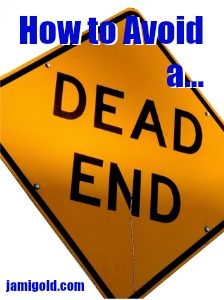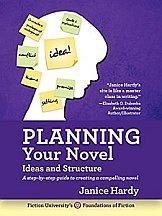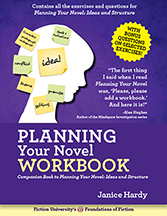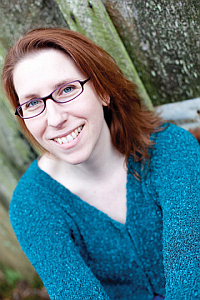Stuck on Plot? Start at the End — Guest: Janice Hardy

Last week, I shared my monthly self-publishing-focused post over at Janice Hardy’s Fiction University, and this week kicks off a short series of monthly posts from Janice that she’s sharing with us here. Yay!
If you’re not familiar with Janice’s site, I highly recommend it. She has tons of great craft posts (and she’s also a wonderful person). *smile*
This month’s post from Janice focuses on planning. Specifically, she shares how knowing the ending of our story can help us plan the rest of the book.
We’ve discussed this technique before when figuring out the emotional arcs of our characters. Today, she’s going to demonstrate how working backward can also help us figure out our story’s plot, especially if we get stuck.
This technique can help both those who plot in advance (plotters) and those who just have the barest ideas and write by the seat of their pants (pantsers). Please welcome Janice Hardy! *smile*
*****
Stuck on Your Novel? Start With the Ending
There are as many ways to write a novel as there are ideas to write about. Every writer has their own process and way of getting from page one to the end. And most of us will stumble during that process at least once during our careers.
And that’s okay.
Writing is a creative process, and sometimes we need to shake up how we do things to get the creative juices flowing again. A process that has always worked for us might utterly fail for a particular story.
If this happens to you, try approaching your novel from a different perspective. Skip ahead and figure out how your story ends to understand how it begins.
Why Knowing the Ending Might Help
Stories are about people solving problems, so a story ends when that problem is resolved. If you’re not sure what constitutes a win for your protagonist, or how she fixes and resolves her problem, then how can you plot toward it? It’s no wonder you got stuck.
(And believe me I’ve been here many, many times. So often in fact, that I now figure out my endings before I start writing a book.)
Luckily, you don’t need to know every detail of how your story ends for this to work. A rough idea of what the problem is and generally how it will be resolved is usually enough to allow you to plot toward it.
Working Backward: Asking Questions & Brainstorming Possibilities
Let’s work through an example:
If you know your protagonist is going to stop the alien invasion and save the world, you’d look at how that’s going to happen.
Ask Questions to Define the Ending:
- What will my protagonist physically do to stop the invasion?
- How is the invasion going to happen (what are the aliens doing to take over the world)?
- How might the alien plan be thwarted?
- How might my protagonist figure that out?
Once you have a basic understanding of how this problem works, you’ll be able to work backward along the plot path.
Identify Steps to Reach the Ending:
Let’s say (blatantly stealing from Independence Day) your protagonist is a skilled computer tech and designs a virus to disrupt the alien ships’ shields so human weapons will reach them. All she needs to do is upload it into the mothership.
- Create the virus
- Find a way to get to the mothership
- Bypass the alien computers and any security protecting the ship
- Get out before getting killed
Of all of these steps, one stands out as a pretty clear plot point—getting to the mothership. If this doesn’t happen, nothing can move forward.
Brainstorm Possible Actions to Complete a Plot-Point Step:
How does the protagonist get to (or get the virus to) the mothership?
- She steals an alien craft
- She flies up in a space shuttle
- She finds an alien computer terminal on the ground with access to the mothership
- She kidnaps an alien and forces it to take her
Any of these could work, but let’s go with stealing an alien ship. You’ve already established that these ships have shields, so getting one is going to be a challenge. You’d have multiple obstacles to overcome, and any of them could be a strong goal and plot point.
Identify Steps to Complete Plot Point:
- Find a way past the shields
- Find someone to fly the ship
- Find a ship on the ground to steal
Each of these can spawn several options and things to try. You can even work in subplots at this point.
Brainstorm Options for Completing Step:
Maybe the only pilot she knows who’s willing to try this crazy plan is an ex-husband she never got over (or who never got over her–awkward).
Maybe there’s a government program the crazy gal she met in chapter three used to belong to, or knows about in some way. But to get her to help, the protagonist has to risk something even worse than alien enslavement.
Repeat as Necessary…
The Benefits of Starting With the Ending
See how easy it is to come up with potential ideas and plot points? Naturally, not every idea will be worth pursuing, but you can brainstorm as much as you’d like.
If figuring out two or three major moments near the end is all you need, just do that. If you’re having fun and want to plot all the way back to page one, go for it. Adapt this technique to your process and make it work for you.
For some writers, just having a better sense of what the story problem is will get them past their sticking points and back to writing. Other writers will have a blast working backward and coming up with all kinds of ideas they’d never have thought of otherwise.
Knowing where you’re going is sometimes all it takes to find the right path to getting there.
*****
Win a 10-Page Critique From Janice Hardy
Three Books. Three Months. Three Chances to Win.
 To celebrate the release of my newest writing books, I’m going on a three-month blog tour–and each month, one lucky winner will receive a 10-page critique from me.
To celebrate the release of my newest writing books, I’m going on a three-month blog tour–and each month, one lucky winner will receive a 10-page critique from me.
It’s easy to enter. Simply visit leave a comment and enter the drawing via Rafflecopter. One entry per blog, but you can enter on every stop on the tour. At the end of each month, I’ll randomly choose a winner.

Looking for tips on writing your novel?
Check out my book Planning Your Novel: Ideas and Structure, a series of self-guided workshops that help you turn your idea into a novel, and the just-released companion guide, the Planning Your Novel Workbook.
*****
 Janice Hardy is the award-winning author of The Healing Wars trilogy and the Foundations of Fiction series, including Planning Your Novel: Ideas and Structure, a self-guided workshop for planning or revising a novel, the companion Planning Your Novel Workbook, and the upcoming Revising Your Novel: First Draft to Finished Draft.
Janice Hardy is the award-winning author of The Healing Wars trilogy and the Foundations of Fiction series, including Planning Your Novel: Ideas and Structure, a self-guided workshop for planning or revising a novel, the companion Planning Your Novel Workbook, and the upcoming Revising Your Novel: First Draft to Finished Draft.
She’s also the founder of the writing site, Fiction University. For more advice and helpful writing tips, visit her at www.fiction-university.com or @Janice_Hardy.
Website | Facebook | Twitter | Goodreads
Amazon | Barnes & Noble | iTunes | Indie Bound
*****
Thank you, Janice! I love how you point out that we only need to work backward as much as we need to get unstuck. As a pantser, I’m a big believer in not doing extra plotting work. *grin*
I often don’t know how my characters are going to get out of the jam I write them into until I get there. But thinking about this process, I can still take what I do know to help me work backward.
Maybe I have an image in mind for the type of showdown involved:
- Where will it take place?
- Are they coming into the showdown with injuries or other obstacles (kidnapped, sneaking around, ticking clock, etc.)?
- Who’s present at the big confrontation?
Each detail we do know can help us work backward toward our ending. We’d know that we need to set up those obstacles and get all the characters into the right place at the right time.
Or maybe we can ask ourselves about the elements that need to be part of our story’s climax:
- Will we end with a cliffhanger or hooks to future stories?
- Are there multiple antagonists to overcome?
- At what point are the subplots wrapped up? Do they tie into the ending of the main plot?
- How will the plot echo or involve the characters’ false belief, fear, or wound?
No matter what we know or don’t know about our story, any information we have can help us work backward to develop our plot. And whether we like knowing every step or we’re just trying to get unstuck, we can use this technique for figuring out our Points A, B, and C on our way to D. *smile*
How do you like to plot (or are you a pantser)? Have you ever plotted the ending first? What works or doesn’t work for you with this technique? Is it easier for you to work forward when plotting (A causes B) or backward (what would cause B to happen)? Do you think this technique might help if you get stuck?
Pin It
Great advice. I usually get about 10k words into a manuscript before I have to figure out the end to move on. One thing that helps me when I get stuck is reading a random post or two from my favorite writing blogs. 😉 It almost always kicks my muse awake.
I do the same thing (the blog posts). Re-reading my favorite books works, too.
Having a direction is definitely a plus!
Absolutely!
I’ve always found it easier to start at the end, so to speak. I like knowing where I’m going even though I’m a pantser at heart. Appreciate the good advice.
Most welcome. I’d imagine it would be very helpful to pantsers.
Thanks for a timely post, Janice. I’ll use it to revisit my WIP. Sometimes I get stuck because I can visualize too many ways to end the story ( I think I’m a “plotting pantser” who gets lost in too many rabbitholes).
That would be challenging. One thing you might try, is to see how all your ending options resolve your protagonist’s goal. Odds are she’ll have one main problem she’s been dealing with all book, and whichever ending best resolves that problem is probably your best ending.
I’ve though of this before, working backwards. But you identified a few simple steps to make it logical and easy. Thanks.
Glad I could help!
I always start off with some idea of a resolution. But in my current work in progress, what I thought would be the resolution happened in chapter 11. It left my characters with a new problem, but I haven’t figured out how to resolve the new problem.
Ooo, that sounds rough. If the ending happened that quickly, there’s a good chance either that’s not the right ending, or you really have a novella instead of a novel.
You might try looking back at your beginning and see if the story problem is what you think it is (sometimes they change as we write). Maybe there’s a bigger issue at hand and the chapter 11 resolution is only the first part. Or maybe there’s another aspect you didn’t explore that would flesh out the book.
Hope this helps!
I usually think I know where I’m going, it’s mapping the route that takes surprising twists and turns.
And that’s fine if your process works that way. Lots of writers discover the story as they write it. 🙂
This is great advice for me right now. I’m plotting a new MS and have a whole – um, how do I do that, type conversation in my head. I’ll try this!
Hope it works for you! If you’re still stuck, try looking at the major turning points first and get a rough idea sketched out, then focus on the specifics between those points. Sometimes it helps to look at the bigger picture first to provide a framework for the plot, then you can flesh that framework out.
Loving the blog tour, Janice. Got to visit an undiscovered site, and now at Jami’s feeling comfy and at home.
I have very defined characters and know exactly where I want them all to be on the last page. Many revisions on beginning, midpoint and climax, and all the stops in between – but the last page never changes.
Thanks! Glad you found someone new 🙂 I’m fortunate to be visiting some amazing blogs n this tour.
Nice. I bet that’s very helpful (and sometimes frustrating, hehe) during your first draft. Whenever you get stuck or lost, you can check your “map” and get back on track.
I like the idea of skipping ahead and writing the ending as a way to help get unstuck. Usually, I just slog my way through and end up having to do major revisions in that “stuck” section. Thanks for the suggestion.
Most welcome. I have a friend who writes out of order, and you might consider that as well. If one scene stumps you, skip ahead to the next scene and continue on. Either you figure out how to fix that section, or you realize you don’t need it.
Thanks for the great suggestion. I sometimes find that when I’m writing forward, my characters have so many potential choices that it’s overwhelming. Knowing where they’re going should make it easier to make those choices.
It works for me 🙂 Just having a direction to aim at helps narrow down the possibilities to a manageable number.
This is a tim lay post for my current WIP. I am also a plotting pantster and having no idea how the novel would end meant I had no direction or too many directions to go in! Having a finite point will definitely help. Jami and Janice, thank you for sharing your writing wisdom.
Most welcome, and I hope it serves you well.
I’m a pantster working my way to plotter. Each mss seems to be a different process. I write contemporary romance so I know my ending will be a HEA, I’m just not sure how the H/h will get back together. Thanks for the suggestions, I’ll work through them.
If you haven’t tried it yet, you might consider a very basic three-point structure. Not a lot of outlining so it shouldn’t mess up your pantsing style, but just enough to guide you so you stay focused.
Here’s the link to my blog if you’re curious to explore this more: http://bit.ly/2aFKAuG
Yes, I’ve read that post and the links in it a few months ago. It’s helped, thanks.
I never start writing until I know how my novel’s going to end–therein lies madness. But then, I’m a plotter. Back in the day, I started several stories without knowing how they would finish, and wouldn’t you know it–I never finished them.
I’m that way now, but I started out the opposite (I guess I still do, actually). I can’t write a book until I have the right opening scene and first line. I used to just wing my endings, but after several messes (and the madness) I realized I needed to know more.
Janice, this is great. I’ve worked backwards before, but never with such a clear definition. I’ve been reading your blog for a long time, but don’t ever comment. Keep up the great work.
Thanks, Jami. Another great post.
Thanks, glad it was helpful. A little guidance and direction can be quite useful to keep us focused.
Thanks! Great advice for a pantser working on becoming a plotter!
Most welcome. You can still hold onto your pantser roots. A little plotting and planning might be enough to keep you on track and still give you the freedom to write organically.
As a scene writer, this kind of thing is hugely helpful. I get my books as scenes and then I have to figure out how they all go together. And the ending scene in often one of the first ones to come to me. 🙂
I have a friend who writes like that. Totally out of order. I’m glad I was able to make that a little easier for you 🙂
This is so helpful. I often write a few scenes at the beginning, then write the climax. It helps me know what I’m aiming for.
And I also write like Jenny Hansen — a scene here, there, and so on, and then pull it all together at the end. Like putting together a crossword puzzle, and, just like that, I need to know what the final picture is going to be.
Another scene-sewer! I’ve been seeing more and more of you guys. It’s so cool to see so many with so many different processes.
Thanks for the great advice. I’m brainstorming a story now and stuck. I’ll try this.
Hope it helps! If not, I’ve found taking a hot shower and washing my hair almost always helps get me unstuck 🙂
This is so helpful. I have a WIP that I had temporarily parked for my own sanity and the safety of those around me. I always had the ending, but the gigantic space between start and finish was a minefield for me.
My focus was on creating all these fascinating scenes, not on the problem or the resolution, and somewhere along the way I missed the point that the middle is what weaves it all together. Of course nothing worked, how could it? I can’t wait to dust it off and apply this process to it, thank you!
Most welcome! I’m so happy this helped you. I hope it gets that story back on track and you can finally get it written.
[…] you’re stuck on plot, Janice Hardy advises starting at the end and also looks at using internal conflict to create […]
So, if I understand thing correctly, is it a matter of just knowing your ending, or should you actually write the ending? The reason I ask is because I’ve often heard you should never write the ending; however, as a pantser, I almost feel that it might work better that way = hence why I absolutely love this article. Thanks in advance for taking the time to answer me.
[…] the past few months, we’ve been enjoying tips on planning and revising in guest posts by the fantastic Janice Hardy. Her post on revising focused on […]
[…] Arcs & Don’t Get Stuck: What should we do if we get stuck in our plot? Or with our character? How do we develop a character arc? How can we avoid a “sagging […]
[…] Stuck on Plot? Start at the End […]